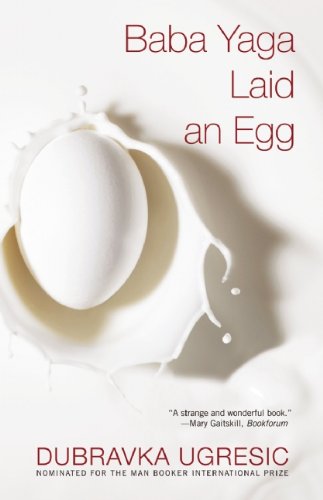All books / Book
Baba Yaga Laid an Egg

| Full title: | Baba Yaga Laid an Egg |
|---|---|
| ISBN: | 9780802145208 |
| ISBN 10: | 0802145205 |
| Authors: | Ugresic, Dubravka |
| Publisher: | Grove Press |
| Edition: | Translation, Reprint |
| Num. pages: | 336 |
| Binding: | Paperback |
| Language: | en |
| Published on: | 2011 |
Read the reviews and/or buy it on Amazon.com
Synopsis
"Baba Yaga is an old hag who lives in a house built on chicken legs and kidnaps small children. She is one of the most pervasive and powerful creatures in all mythology." "But what does she have to do with a writer's journey to Bulgaria in 2007 on behalf of her mother?" "Or with a trio of women who decide in their old age to spend a week together at a hotel spa?" By the end of Dubravka Ugresic's novel, the answers are revealed. Her story is shot through with spellbinding, magic, involving a gambling triumph, sudden death on the golf course, a long-lost grandchild, an invasion of starlings, and wartime flight, the consequences of which are revealed only decades later.
Kirkus Reviews
Expatriate Croatian novelist and essayist Ugresic (Nobody's Home, 2008, etc.) spins contemporary fiction from a popular figure in Slavic folklore. Baba Yaga is a witch who flies through the air in a mortar and lives in a house supported by chicken legs and surrounded by heads on pikes. She is a source of occult knowledge; Day, Sun and Night are her servants. She is, it goes without saying, hideous-withered and skeletal. Although she is usually depicted as a villain, Baba Yaga can also be a benefactor. The author plays with this ambivalence as she weaves the witch into interconnected stories of women living in present-day Eastern Europe. In the first section, a writer describes her relationship with her dying mother. The second portion describes three elderly friends increasingly disturbed by their ancient bodies as they try various spa treatments at a Czech resort. Both stories abound with symbols associated with Baba Yaga, and in the final section a fictional folklorist named Dr. Aba Bagay explicates the preceding narratives in an essay called "Baba Yaga for Beginners." This last bit may sound like trite postmodernism, but Ugresic is far too confident a practitioner to engage in mere posturing. (She's a contender for the 2009 Man Booker International Prize.) Her instincts as a storyteller are sure-the first two sections work just fine on their own-and her scholarly postscript is both interesting and entertaining. This volume makes a nice addition to Grove's The Myths series, which also includes Margaret Atwood's The Penelopiad (2005) and Alexander McCall Smith's Dream Angus (2006). A playful, inventive and humane look at women and aging.